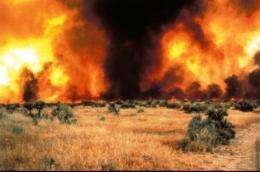Tracking invasive cheatgrass role in larger, more frequent Western fires

New research that relied in part on satellite images suggests that cheatgrass, an invasive species brought west by settlers in the 1800s, is one cause for the larger, hotter and more frequent range fires experienced recently in the Great Basin of the American West. The arid region covers about 230,000 square miles (600,000 km) over much of Nevada and parts of Utah, Colorado, Idaho, California and Oregon.
Bethany Bradley, a biogeographer at the University of Massachusetts Amherst, brought her expertise in remote sensing and spatial analysis to the study, which was led by fire expert Jennifer Balch of Penn State University.
Bradley used data from NASA's Moderate Resolution Imaging Spectoradiometer from 2000 to 2009 to detect burned areas to create the first land cover map for the Great Basin area. With it, the two researchers and their colleagues combined data sets, matched fire dates and perimeters with land cover data to reach their conclusions, reported in the current online edition of Global Change Biology.
Bradley, Balch and colleagues say that over the past 10 years, cheatgrass fueled most of the largest fires, influencing 39 of the largest 50. Also, fires in grass-covered lands were on average significantly larger than the average fire size on lands dominated by other types of vegetation such as pinyon-juniper, montane shrubland and cultivated areas.
Data also suggest that cheatgrass plays a role in more frequent fires. "From 2000 to 2009, cheatgrass burned twice as much as any other vegetation," Balch says.
"Although this result has been suspected by managers for decades," the authors note, "this study is the first to document recent cheatgrass-driven fire regimes at a regional scale."
Bradley points out, "One of the tricky things about fires in the West is high year-to-year variability. Grass fires tend to occur the year after a wet year, because there is plenty of dry, standing biomass ready to be burned. So trying to figure out this fire relationship you need to have a time series with enough fire years to produce a strong signal. With a full decade of data, we were able to capture the relationship."
She adds, "Cheatgrass leaves a continuous cover, which is why it may burn more frequently. The native vegetation in such dry landscapes is often shrubby and separated by bare soil, which can stop a fire, but cheatgrass forms a continuous fuel."
Balch points out that one of the consequences of more widespread cheatgrass fires is that landscapes dominated by it have a shorter fire-return interval, the time between fires in a region. For cheatgrass-dominated areas it is 78 years, compared to a 196-year interval in areas dominated by another species such as sagebrush.
"What's happening is that cheatgrass is creating a novel grass-fire cycle that makes future fires more likely," Balch explains. "Fire promotes cheatgrass and cheatgrass promotes fires. And cheatgrass-influenced fires create a difficult management challenge." They can threaten agricultural lands, residential areas as well as habitat for vulnerable native wildlife.
The new information from this study will be useful to management agencies in the West, Bradley says. "Managers have until now been trying to model fire risk under future climate and development conditions without any information on cheatgrass's influence. So now they have one more tool to introduce more information and accuracy into their models."
In the future, the research team hopes to use this regional approach to learn more about how different landscape types such as shrub, forest and wetland ecosystems respond to climate on a yearly basis. "Using remote sensing we can relate climate conditions to fire response and ecosystem phenology over time, and potentially predict how those ecosystems might be affected by consistently warming temperatures in the future," Bradley says.
Journal information: Global Change Biology
Provided by University of Massachusetts Amherst

















